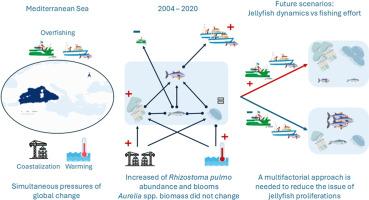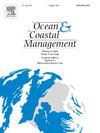Beyond single drivers: A multi-stressor framework for understanding and managing jellyfish proliferation under concurrent anthropogenic and climate pressures
IF 5.4
2区 环境科学与生态学
Q1 OCEANOGRAPHY
引用次数: 0
Abstract
The Mediterranean Basin is a biodiversity hotspot increasingly threatened by anthropogenic pressures, such as coastalization, overfishing, and climate change. These stressors may contribute to jellyfish blooms, which jeopardize marine ecosystems and the services they provide. Yet, their combined effects remain poorly understood. This study models the responses of two jellyfish with contrasting thermal preferences, Rhizostoma pulmo and Aurelia spp., to global changes occurring in the Western Mediterranean Sea between 2004 and 2020. The loop analysis method was used to assess the combined effects of multiple anthropogenic pressures on the abundance of jellyfish and the model outputs were compared with the observed dynamics of both jellyfish. Results suggest that global change favored R. pulmo proliferation during the study period, whereas Aurelia spp. abundance did not show much change. The effects of different fishing effort scenarios on jellyfish blooms were also modeled to provide Western Mediterranean stakeholders with keys to remediation. While increased fishing effort in a context of global change is expected to foster jellyfish proliferation, reducing fishing pressure alone is unlikely to curb their abundance, because of the influence of concurrent antagonistic drivers. Our results highlight the multifactorial nature of jellyfish blooms and the need for integrated approaches to mitigate their proliferation. This study contributes to the objectives of the EU's Marine Strategy Framework Directive by improving the understanding of jellyfish as indicators of ecosystem imbalance and informing ecosystem-based management strategies.

超越单一驱动因素:在人为和气候压力下理解和管理水母增殖的多压力源框架
地中海盆地是生物多样性的热点地区,受到海岸化、过度捕捞和气候变化等人为压力的威胁日益严重。这些压力源可能导致水母大量繁殖,从而危及海洋生态系统及其提供的服务。然而,人们对它们的综合影响仍然知之甚少。本研究模拟了2004年至2020年间西地中海发生的全球变化对两种具有不同热偏好的水母——pulmo根纹水母和Aurelia spp.的反应。利用循环分析方法评估了多种人为压力对水母丰度的综合影响,并将模型输出与两种水母的观测动态进行了比较。结果表明,在研究期间,全球变化有利于黄颡鱼种群的增殖,而黄颡鱼种群的丰度变化不大。还模拟了不同捕捞努力情景对水母繁殖的影响,为西地中海利益相关者提供了修复的关键。虽然在全球变化的背景下增加捕捞量预计会促进水母的繁殖,但由于同时存在拮抗驱动因素的影响,仅减少捕捞压力不太可能抑制水母的数量。我们的研究结果强调了水母繁殖的多因素性质以及采取综合方法来减轻其增殖的必要性。这项研究通过提高对水母作为生态系统失衡指标的认识,并为基于生态系统的管理战略提供信息,有助于实现欧盟海洋战略框架指令的目标。
本文章由计算机程序翻译,如有差异,请以英文原文为准。
求助全文
约1分钟内获得全文
求助全文
来源期刊

Ocean & Coastal Management
环境科学-海洋学
CiteScore
8.50
自引率
15.20%
发文量
321
审稿时长
60 days
期刊介绍:
Ocean & Coastal Management is the leading international journal dedicated to the study of all aspects of ocean and coastal management from the global to local levels.
We publish rigorously peer-reviewed manuscripts from all disciplines, and inter-/trans-disciplinary and co-designed research, but all submissions must make clear the relevance to management and/or governance issues relevant to the sustainable development and conservation of oceans and coasts.
Comparative studies (from sub-national to trans-national cases, and other management / policy arenas) are encouraged, as are studies that critically assess current management practices and governance approaches. Submissions involving robust analysis, development of theory, and improvement of management practice are especially welcome.
 求助内容:
求助内容: 应助结果提醒方式:
应助结果提醒方式:


